“and how did you like Japan?” that’s what you probably would want to ask me, dear people, is that right? an amusingly leading question, forcing me into defensiveness, into iamstilladjusting and ohitsquiteokayiguess and iamnotatalldisappointed. one cannot possibly say “it’s just like i imagined,” because, frankly, what had i actively imagined before? apart from handsome, teary-eyed Matsugae Kiyoaki of course. art created a million little closed off worlds before and there was no shinkansen to board to connect them, to hop from city to city, from season to season, between periods of time; no means to create a continuum. art creates an arbitrary sense of space and time; a stringent, polyphonic framework of structure and meaning whose building blocks are random, as i pull works of art from the shelves of a library as i fancy. and, needless to say, by a wondrous sleight of hand Japan also tends to deliberately disseminate an artistic, melancholy, refined public image — to find this skillfully arranged gift wrapping enveloping something strikingly different, something that took years to begin to understand, and to peel the scented tissue paper back and find what’s conflicted, raw, and living beneath, that was my task.
ambivalence, comfort, serendipity, that is Japan. an intricate interplay of taxing context and meaning, entirely, maddeningly too much of both, that is Japan. nobody asking “why?”, that is Japan, too. self-imposed rules of a society living in wildly organic, disheveled cities, some of them resembling Matryoshka dolls, that is Japan, too. a serious case of arkoudaphobia, that is Japan. and Japan is the gently omnipresent dilemma, whether fate or coincidence is exerting a bigger force on any given day.
but i invited you to play a game with me, and i must say, i had some serious fun while at it. there is only one thing more jarring than standing at the exact location some book i read mentioned — standing at such a location and just having a hunch, but not remembering precisely where or when i read about it before. fate, coincidence, either, or? my choice, my delight. and it all constitutes a single timeline, a single reality. “connecting the dots” is a very imprecise expression and wildly inappropriate in the attempt to describe what had happened in those 2 weeks. living through layers of reality seems to be more accurate.
every time i think of Jeff Goldblum saying “i am the authority of my own experience”, i squeal with glee; because this is what the notion of planning for the unplanned turns us into. walking is essentially planning for the unplanned, whether one puts it in a framework of a ritual (“a thing unto itself”) or not. considering only the most immediate scenarios and actually planning against those is essentially the same, even if we board planes, trains, and automobiles. travel is not centered around “sights” anymore, but rather moments, moods, desires. it comes at a cost however, as our experience becomes heavily edited by the unplanned, the colors of happenstance bleeding through the pages of our Lonely Planets and Fodor’s. simply put, we will inevitably miss out on certain things, but hopefully, gain a deeper understanding of others thanks to the confrontation with the unplanned. one has to make peace with these newly established filters, i keep reminding myself, or else we fall into the trap of longing (for the millennials out there: FOMO).
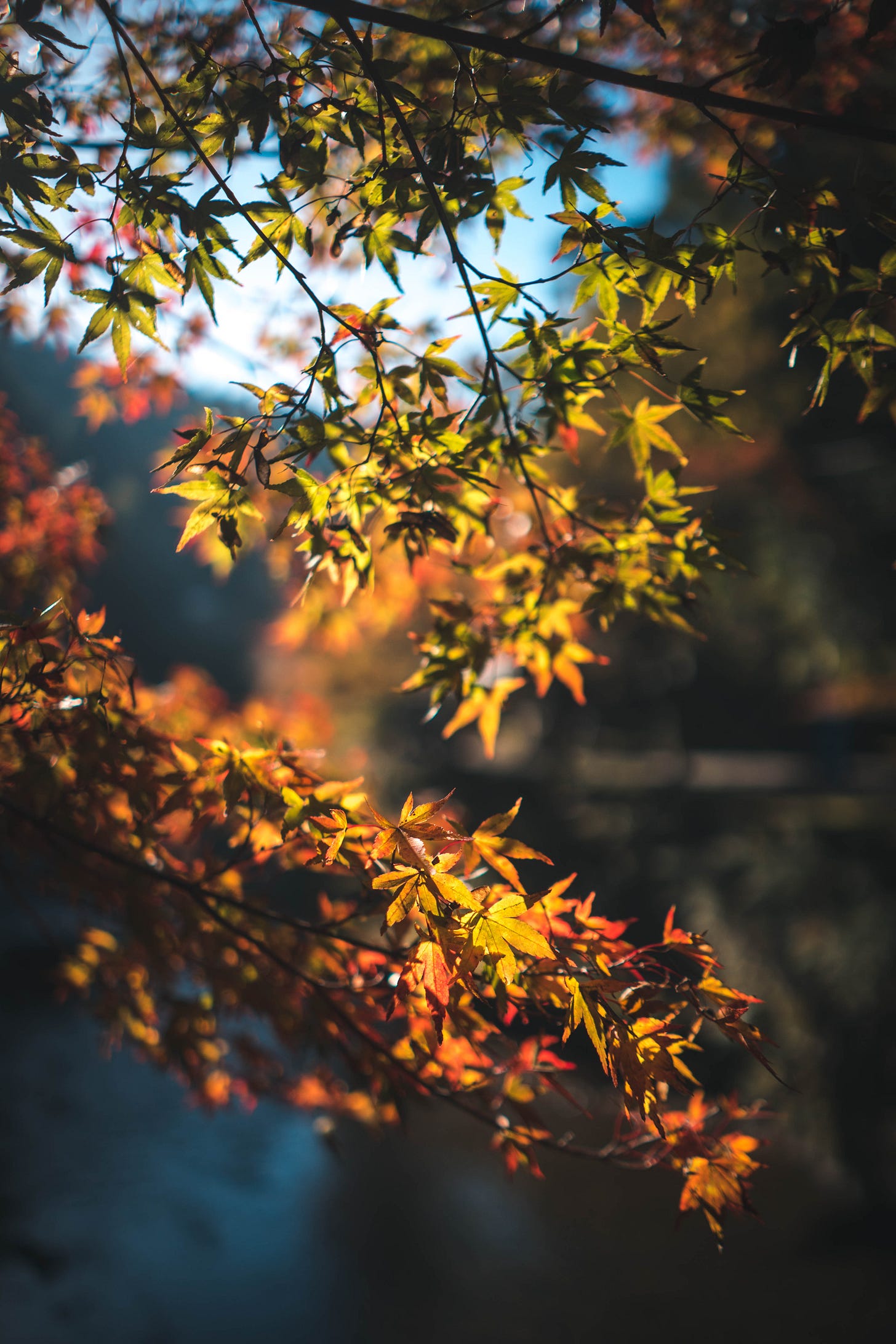
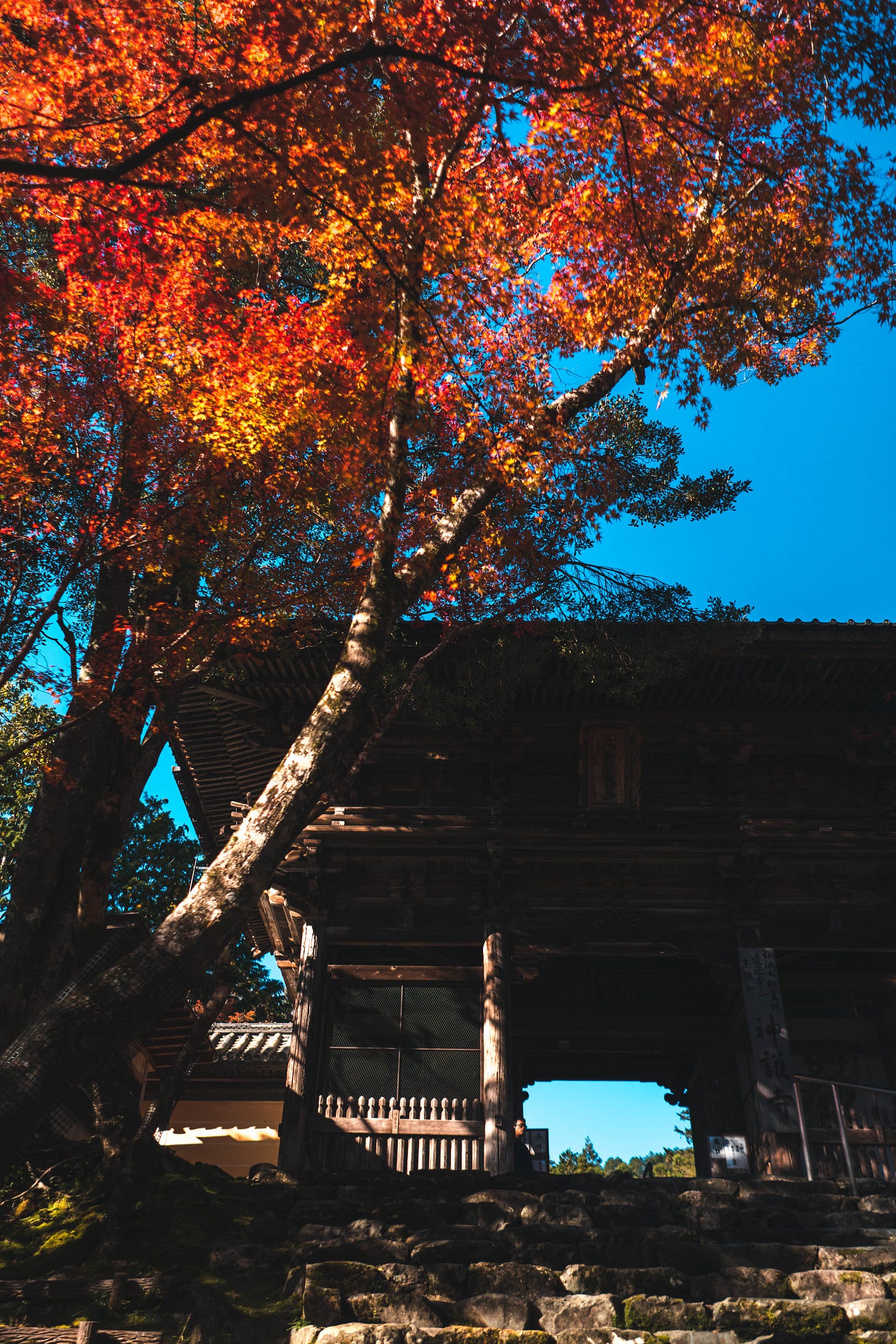

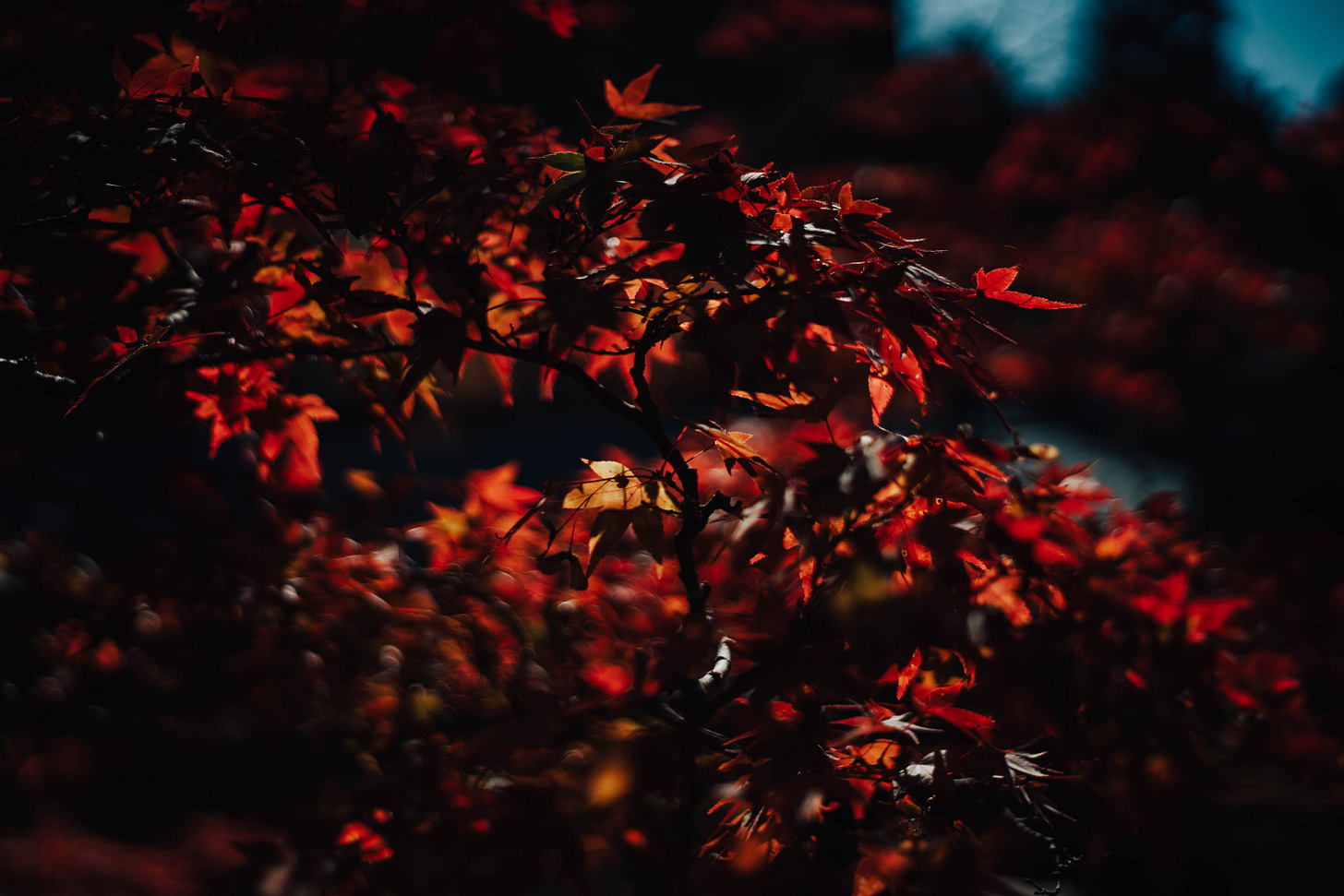
momiji at the Jingo-ji, Takao (Kyoto)
“The bus had reached Takao.
‘Where has Takao gone?’ one passanger asked.
It did indeed look as though Takao had vanished; the maple leaves had all fallen, and a touch of winter rested on the tips of the branches.
The parking lot below Toganoo was empty.
Naeko had come out to the bus stop at Bodai Falls to wait for Chieko. She was in her work clothes.”
of course i did not know i was going to Takao that morning.
“this line has no stops in the city. i repeat: we won’t call at any stops in the city. first stop: Takao,” the driver announced, and i understood every word and yet, i just sat there, with a demented smile plastered on my face. that morning, whatever was fine. in complete surrender to this newly found idleness, i thought of the short but noticeable earthquake the night before.
traffic was extremely slow. the Chinese family wanted to know where to get off for the walk to Jingo-ji. it was still miles away, they were told. how on earth do unnecessarily tall European people sit comfortably in these seats, i wondered. on the winding road beneath Ryoanji i feared that the clunker would simply give in. it didn’t. even my heartbeat felt slow. i considered my options, but nothing really made sense. maybe some other time. the forest seemed to be beckoning, so i got off with the Chinese. nobody was waiting for me at the bus stop. the ubiquitous vending machines stood guard at the slight bend in the road.
i remembered the nearby Bodai-taki as i descended into the narrow valley of the Kiyotaki River and examining the recommended hiking routes, a pang of pointless longing came upon me. what solstice, i thought when it turned out that Jingo-ji was the single most popular and famous scenic spot to view autumn foliage. however, my own presence felt dislocated, as if someone had slid a window shut between me and reality, so that it became inaccessible, until i climbed the stairs and entered the temple. incense brought me back to myself in the richly ornamented, dim-lit main hall, incense that smelled like autumn, like the longing i felt, like the impossibly blue sky over the splendor of momiji, and as i gazed at the hills in the distance, the same invisible hand opened the window, and in that moment, i finally arrived in Japan.

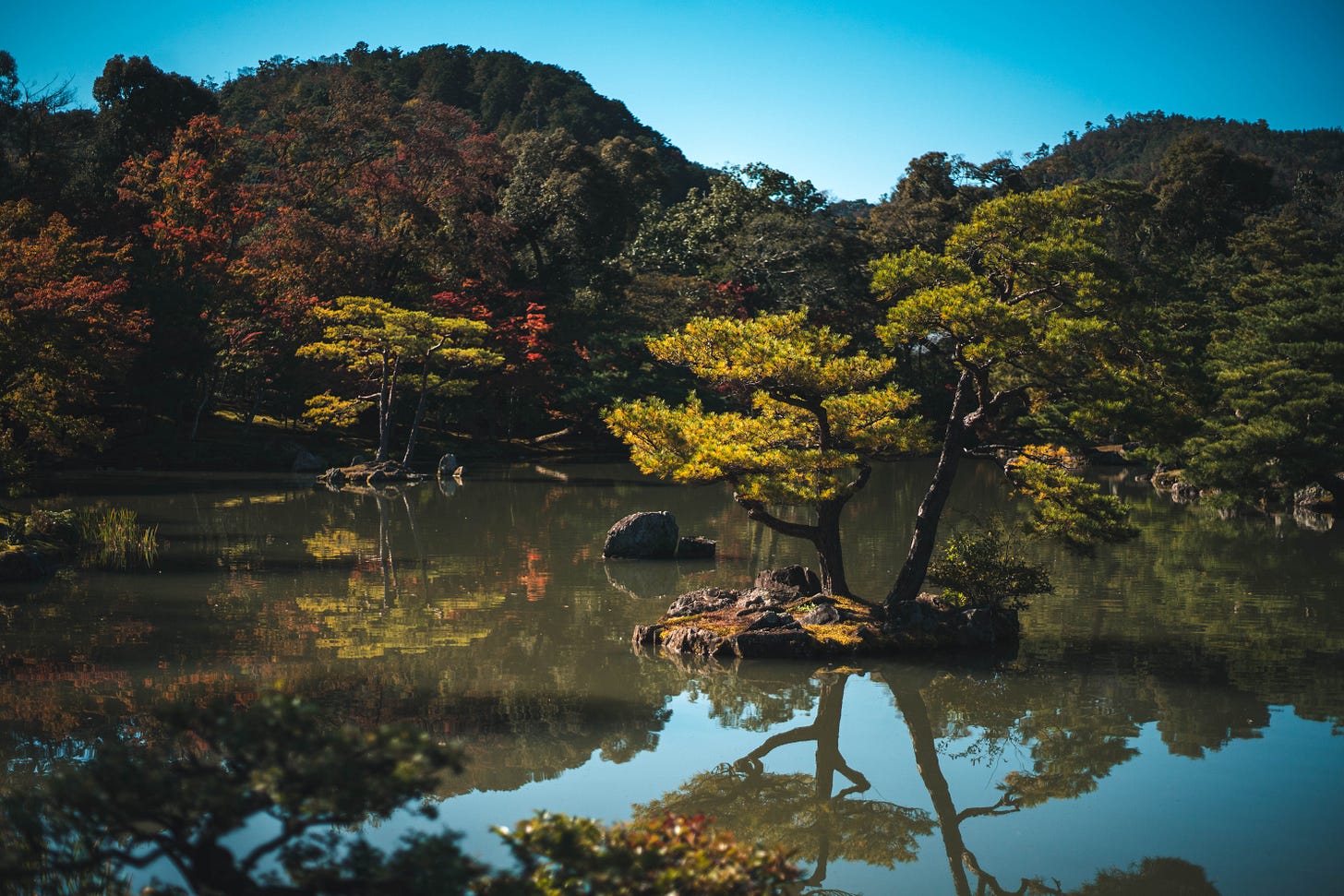
autumn colors and seemingly no visitors at the Kinkakuji, Kyoto
“And beauty synthesized the struggles and the contradictions and the disharmonies in every part of this building — and, furthermore, it was beauty that ruled over them all! The Golden Temple had been built with gold dust in the long, lightless night, just like a sutra that is painstakingly inscribed with gold dust onto the dark-blue pages of a book. Yet I did not know whether the beauty was, on the one hand identical with the Golden Temple itself or, on the other, consubstantial with the night of the nothingness that surrounded the temple.”
“This mysterious copper-gold phoenix never crowed at the break of dawn, never flapped its wings indeed, it had itself no doubt completely forgotten that it was a bird. Yet it would be untrue to say that this bird did not look as if it were flying. Other birds fly through the air, but this golden phoenix was flying eternally through time on its shining wings. Time struck those wings. Time struck those wings, and floated backwards. In order to fly, the phoenix remained motionless, with a look of anger in eyes, holding its wings aloft, fluttering the feathers of its tail, bravely stretching its majestic golden legs.”
(Mishima Yukio: The Temple of The Golden Pavilion)
it’s not an instagram trophy, it’s not, i shook my head bitterly as i entered the park among the crowd of tourists flailing around with their selfie sticks. i noticed the slight tremors and trepidations of my heart and kept fidgeting, stuffing my sweater into my rucksack, wetting my lips, ambling along the path to the pond, and there it was, a childhood dream coming true on a perfect autumn day. i tried to think of words that would describe the alien beauty of the pavilion, but they all eluded me. looking around, i realized that the majority of the visitors wanted to take that one picture, in that same frame and then they left. but the hustle and bustle soon fell away as i walked around the pond (and thought of the snapping turtles handsome Matsugae Kiyoaki was so afraid of); or was it the Golden Temple itself that absorbed all human presence?
there was hardly anyone who would have wanted to see the temple from the mound over the pond, whereas the vista was strikingly different — the only perspective that allowed me to see the phoenix eternally frozen in the moment of taking flight from the top of the pavilion at eye level, surrounded by a symphony of autumn colors, a pearlescent haze floating in the air.
contextless. that was the word, a quality i’ve never seen in architecture before. this building is contextless, its perfection ineffable. beauty, that’s heartbreaking, that drives the beholder insane, should one dwell on it for too long.
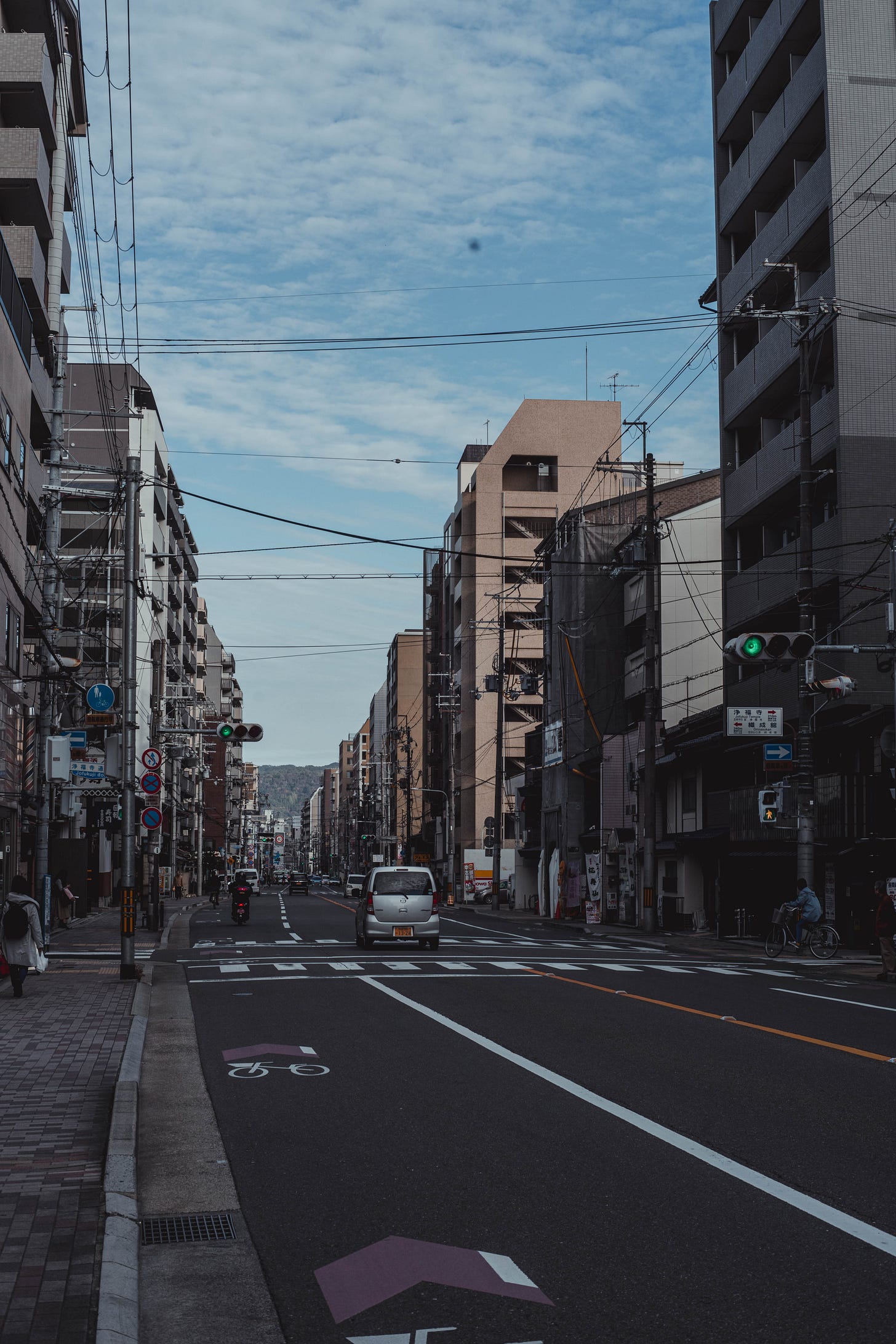
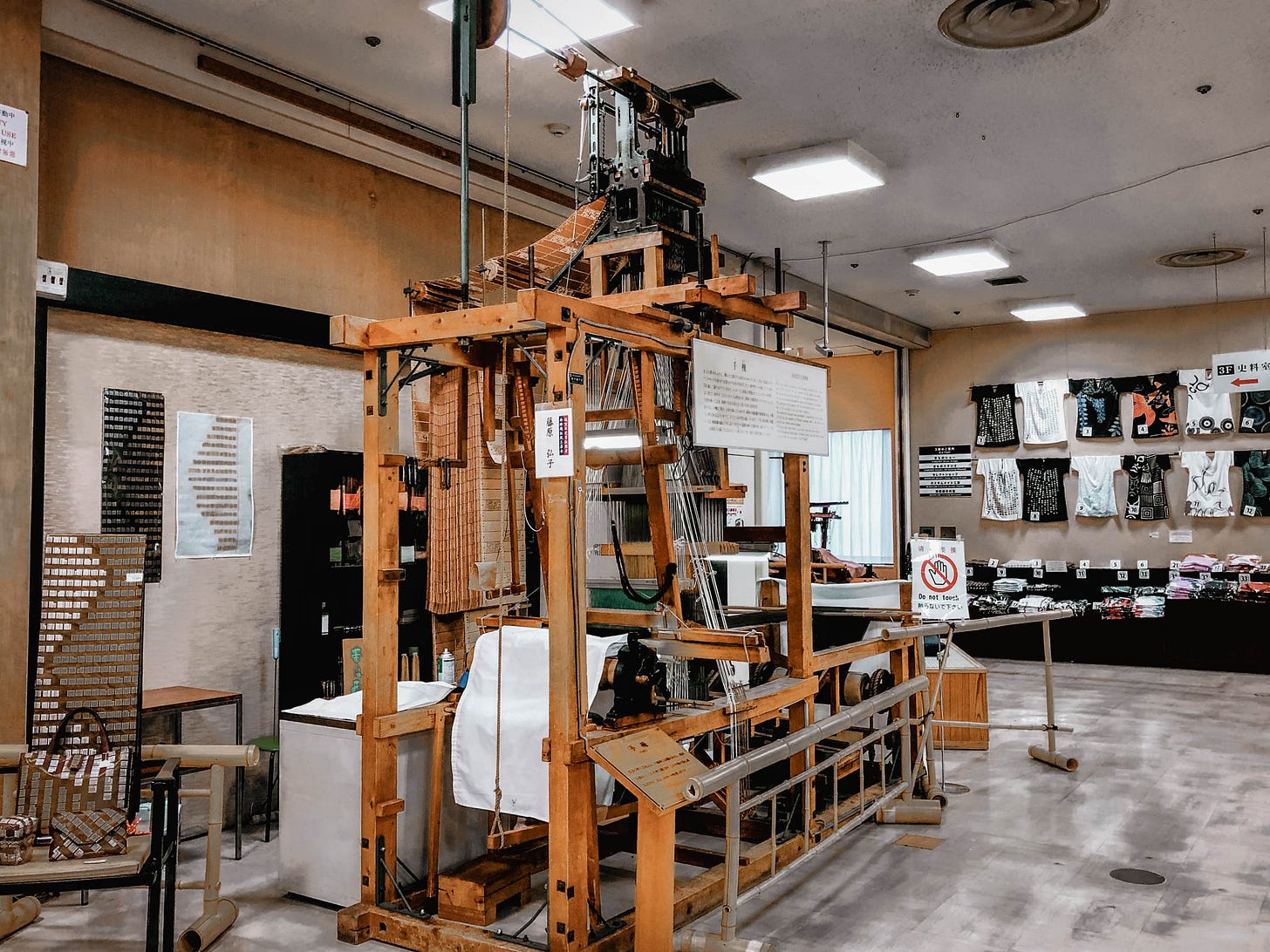
a single loom and a desolate mall, that’s the district of Nishijin, Kyoto on November 13, 2019
“The Nishijin Fabric Weavers Trade Association took an unprecedented measure by stopping all loom work for eight days from November twelfth until the nineteenth. Since the the twelfth and the nineteenth were Sundays, it was actually only a six-day work stoppage.
There were a number of reasons, but in short, the purpose was economic. Overproduction had resulted in more than 300,000 excess bolts of fabric on hand. The purpose was to dispose of some of the stock and improve business. There had also been increasing problems in financing.
From the autumn of the previous year through the spring, some of the trading companies in Nishijin had folded.”
“The streets were also clean in the area around Nishijin, where the small, dispirited kimono shops huddled together. Dust never collected even on the fine latticework of the doors.”
(Kawabata Yasunari: The Old Capital)
there are no kimono shops or whirring looms behind sliding doors with fine latticework in Nishijin anymore. the district that used to be the center of fine silk weaving, famous for its high-shine, pictorial designs combining traditional Japanese craftmanship and Western technology had been turned into a densely populated residential and commercial area. somehow it resembled a spa-town-turned-socialist- nightmare somewhere in the former Eastern Block in the 1970’s. by the time i had entered Nishijin i was certain that Kyoto architects had a penchant for weird proportions and an unusual placement of windows and doors so that facades often strongly resemble faces, or represent an unbearably lousy allusion to more famous buildings, like John Baird’s art nouveau peacock ornament in Glasgow. exasperation washed over me.
the Nishijin Textile Center doesn’t fare any better. as if the collective memory of a nation had been wiped clean, there is precious little information available about the process of silk weaving. a lonely loom occupies much of the second floor space among garish neckties, cheap second-hand kimonos, colorful knick-knacks. there is a set of origami paper in hundred traditional Japanese colors, including exotic, muddy hues like indigo mouse and brown mouse. scraping for the last remnants of a once great tradition made me very tired. i wish i could just sit down somewhere and process the loss of something unmistakeably precious, whose last lustruous moments, whose transience served as a melancholy backdrop for Kawabata’s Old Capital.
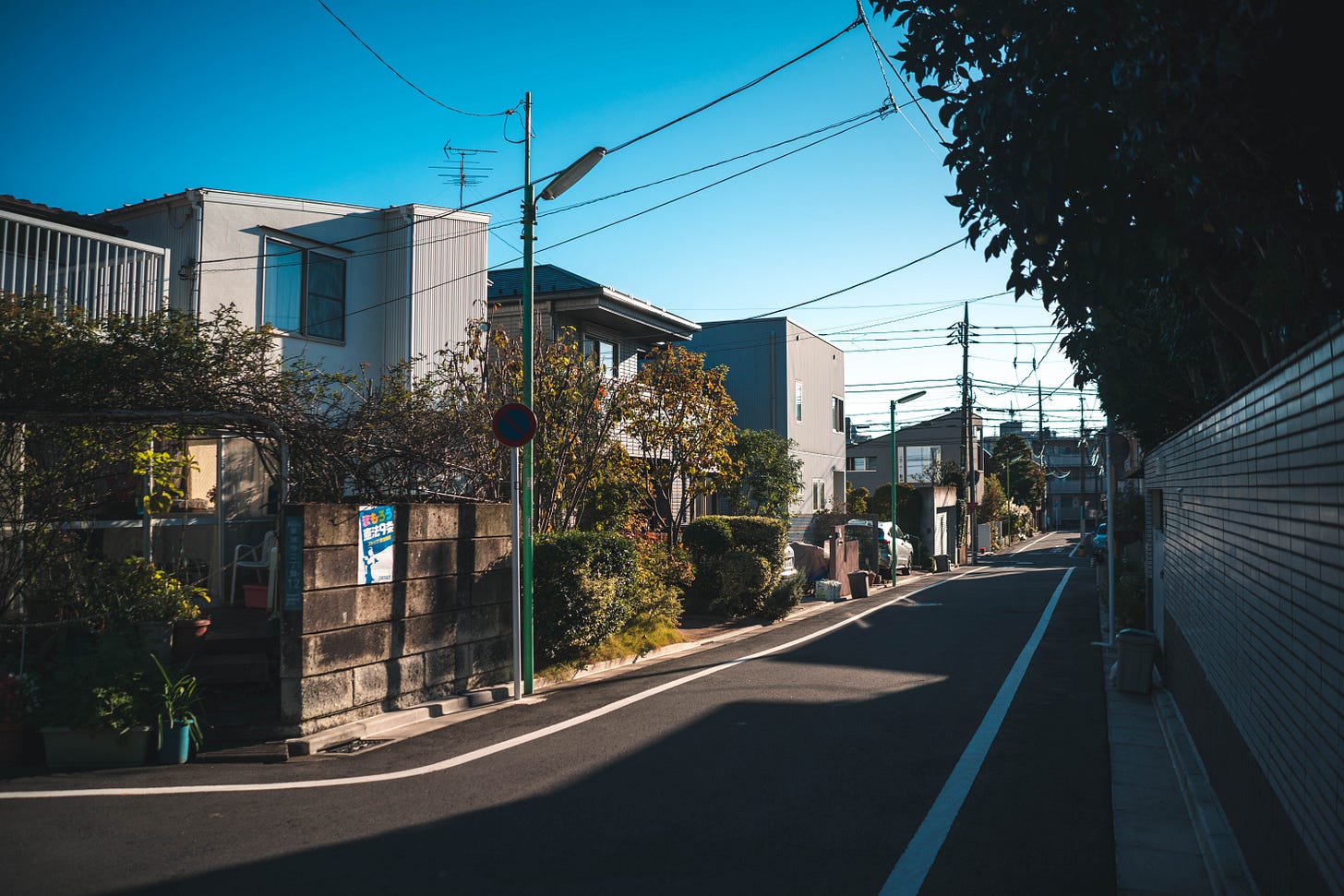
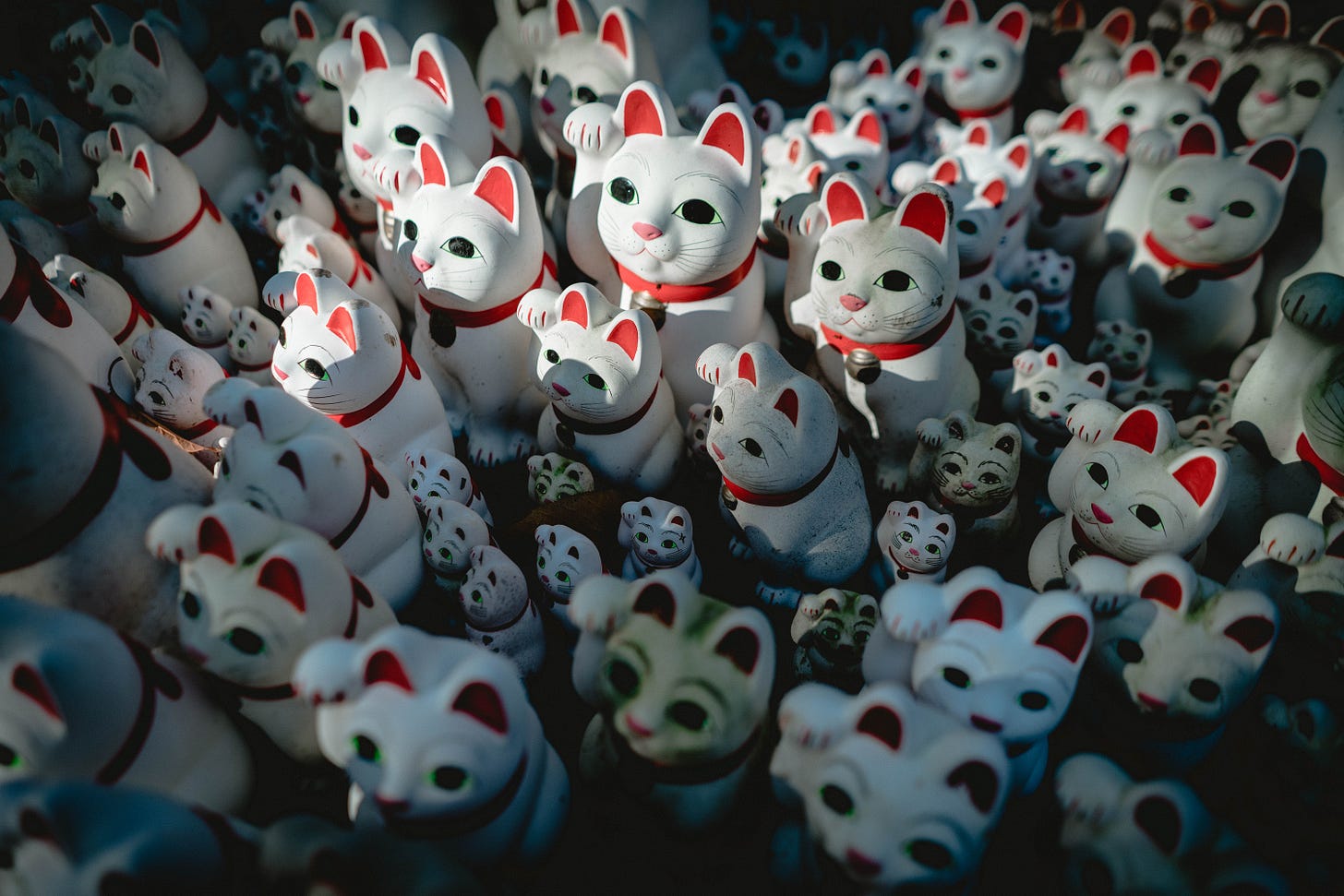

suburb with cats and alleys, Setagaya, Tokyo
“--- 2-chome, Setagaya, the “hanging house.” Located in a quiet residential neighborhood, this 3,500-square-foot piece of prime real estate with fine southern exposure is a virtually ideal location for a home, but those in the know agree on one thing: they wouldn’t take it if you gave it to them. And the reason for this is simple: every known owner of this property, without exception, has met with a terrible fate. Our investigations have revealed that, since the start of the Showa Period, in 1926, no fewer than seven owner occupants of this property have ended their lives in suicide, the majority by hanging or asphyxiation.”
“The present “former Miyawaki residence” is surrounded by a wall far higher than any other in the neighborhood. It has a huge, solid, black iron fence built to discourage peeping (see photo) and a video camera atop the gate pillar. We tried ringing the bell, but there was no response. Neighbors have seen the electric gate open and a black Mercedes 500SEL with tinted windows go in and out several times a day, but there has been no other sign of entry or egress, and no sounds are ever heard from the place.”
(Murakami Haruki: The Wind-Up Bird Chronicle)
commuting, looking at maps and timetables, trying to figure out,which exit to take, waiting for trains, for the subway, for the shinkansen, listening to the same announcement detailing which ones are non-reserved cars over and over again, riding a couple of stops just before or after rush hour — that’s essentially the Tokyo experience. and then there is ominous tranquility in posh residential areas. a city nestled inside a city nestled inside a city, it becomes increasingly difficult to imagine that the empty streets, the post-apocalyptic calm and the deeply indifferent atmosphere of these suburbs are just another brush stroke in a highly complex image full of tension, full of contradictions.
if there was one neighborhood i wanted to experience in Tokyo, then it was Gotokuji in Setagaya. having read The Wind-Up Bird Chronicle made me think about the backdrop to the story. it seemed to be very specific, an autonomous character and not just geographical happenstance. compared to Shinjuku, Daikanyama, Shimokitazawa even, in Gotokuji everything is small, as if one had entered a curious, doll-sized world.
oddly, this reminded me of the neighborhood where i grew up in the Buda hills; time was standing still, hanging suspended in the sunny morning hours eternally. the sun would never set, the children would never go to school, the woman wearing an expensive fur coat would never get to the train station; and the cats of Gotokuji temple would never stop beckoning.
indeed, the cult of the lucky cat, the maneki neko originated here, so it’s no coincidence that Okada Toru goes to search for his missing cat in the novel — although at the temple there are thousands of the same figurine waving at the occassional visitor. the original, holy image is etched into the eaves of the pavilion of Gotokuji, barely visible for the naked eye — a symbol so subtle it quickly becomes unsettling to look at it.
there must be a well in one of these walled gardens, a statue of a bird; someone living the hallmark subdued life of the Murakami heroes, cooking pasta or making a cucumber sandwich. instead of the Mercedes 500SEL a Volvo S60 was parked in front of a Scandinavian-inspired, minimalistic cube; someone must be truly enamored with all things wonderfully European. at the bakery down the main street, an elderly gentleman bought three of everything and then apologized. the young woman behind the counter was terrified. i had a very buttery dinner roll and an almond croissant so flaky and so heavy on the almond paste filling, it nearly dissolved in my palm. i drank coffee and made peace with time standing still in this artifical world.

becoming Shimamura on my way to Snow Country, Hida
“In the depths of the mirror the evening landscape moved by, the mirror and the reflected figures like motion pictures superimposed one on the other. The figures and the background were unrelated, and yet the figures, transparent and intangible, and the background, dim in the gathering darkness, melted into a sort of symbolic world not of this world. Particularly when a light out in the mountains shone in the centre of the girl's face, Shimamura felt his chest rise at the inexpressible beauty of it.”
(Kawabata Yasunari: Snow Country)
it was impossible to resist. exhausted from a day of climbing above Togakushi, i slept through most of the journey to Takayama, but when i finally woke, i found myself transported back into an exquisite literary experience. i was 14 when i first read Snow Country, and kept revisiting this slim book ever since, until it suddenly became my reality. the Hida Express was the mirror to the symbolic world, and for once i was Shimamura, not Komako, and indeed, there was an inexpressible beauty to the pitch black evening and the faint glimmer of the towns and mountains far, far away. it was a seemingly mundane experience, looking out a window which became a mirror projecting layers of everyday reality onto each other, mixing light and darkness, but mirrors are considered sacred objects in Japan since ancient times. the holiness of the moment lay in the unsettling beauty of synchronicity: on my sentimental journey in the mountains i wasn’t only following someone who had already left, but life recreated a moment of fiction, a moment of role reversal, visual and imaginary layers upon layers, until i ended up in an infinitesimal mirror world of my own.
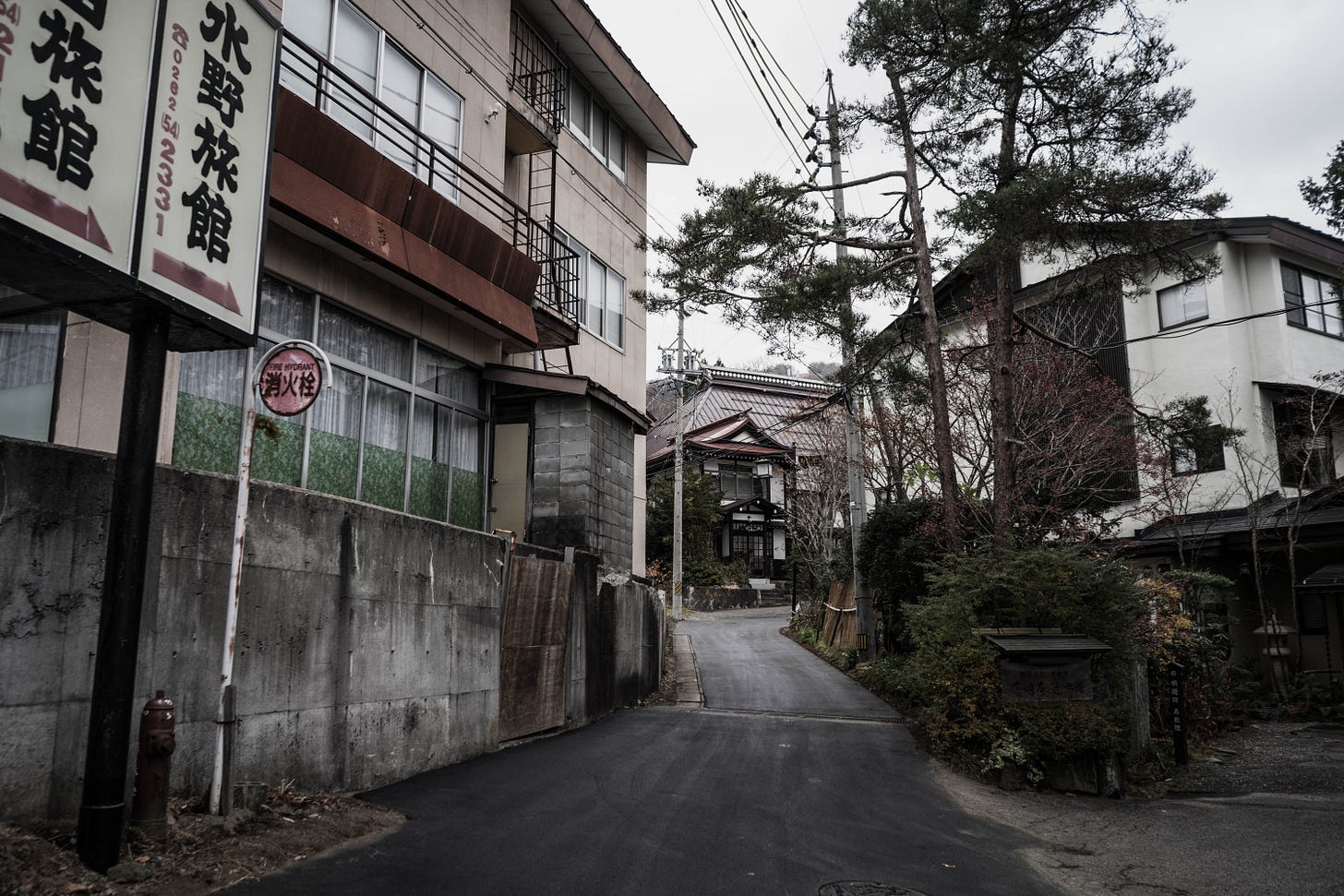
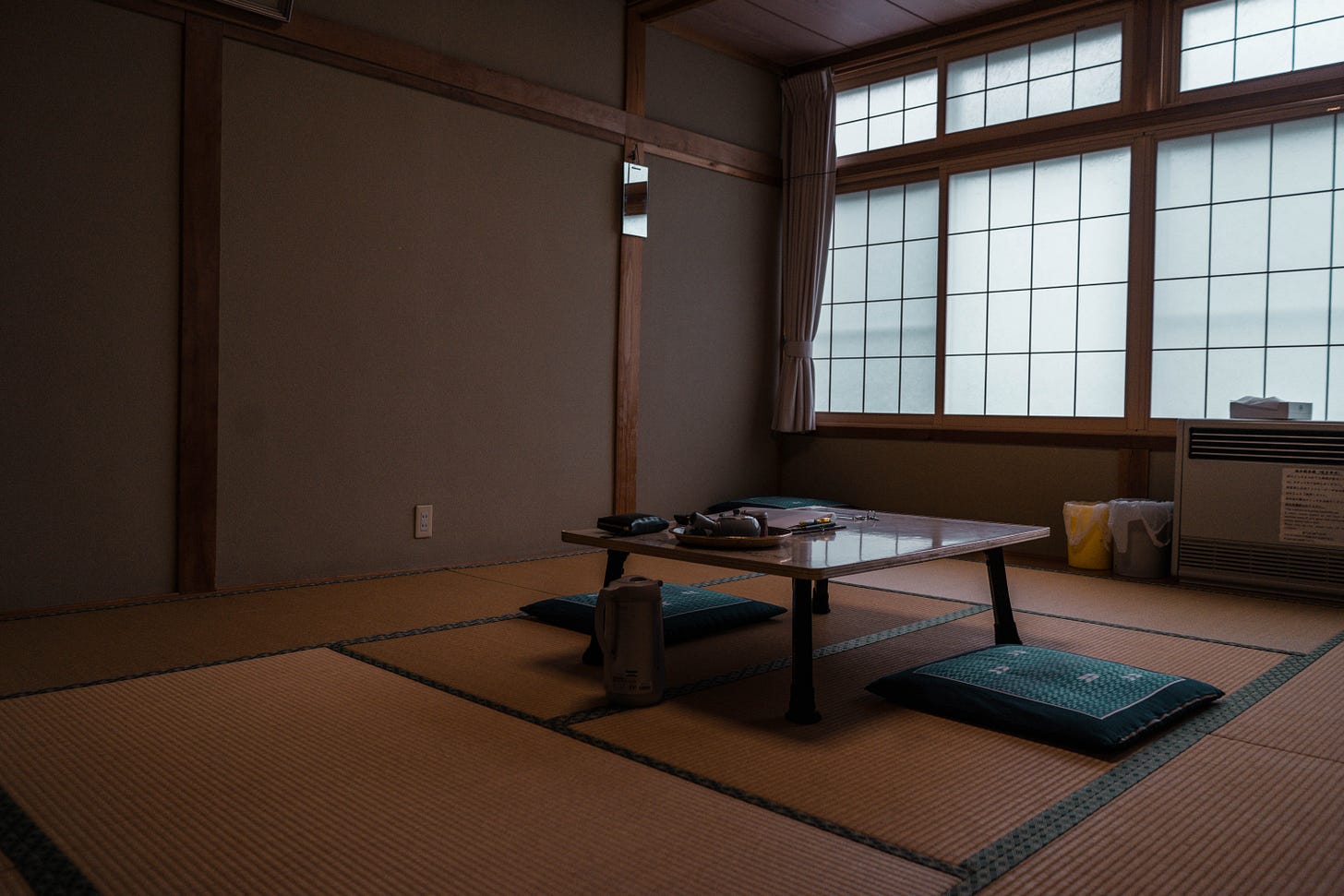
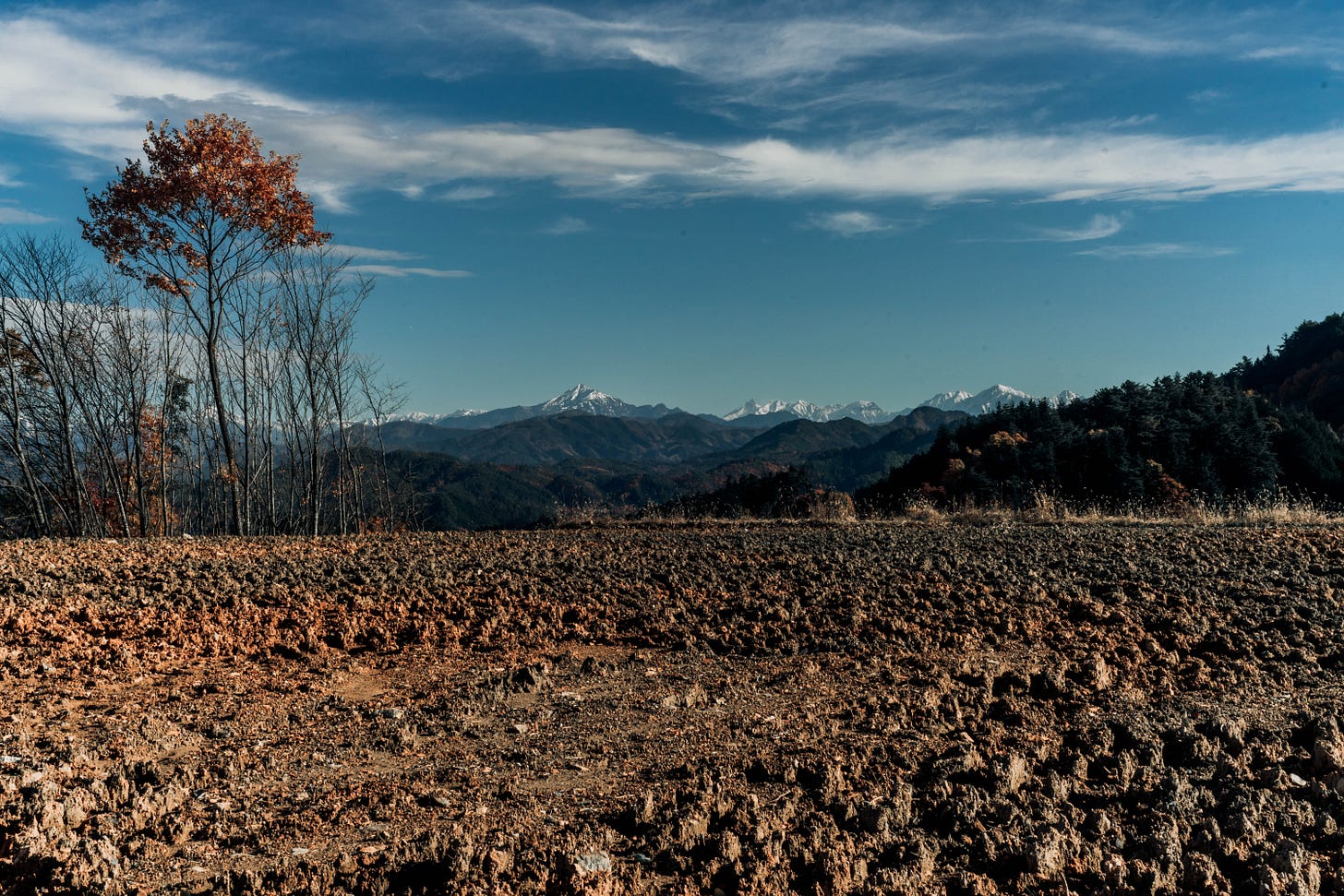
my own version of Snow Country is a montage of images from Togakushi, Nagano, and Enakomachi in Takayama
“The hot-spring inn had its fewest guests in the weeks before the skiing season began, and by the time Shimamura had come up from the bath the place seemed to be asleep. The glass doors rattled slightly each time he took a step down the sagging corridor. At the end, where it turned past the office, he saw the tall figure of the woman, her skirts trailing coldly across the dark floor.”
“The snow on the distant mountains was soft and creamy, as if veiled in a faint smoke.”
(Kawabata Yasunari: Snow Country)
i knew i kept constructing a world i felt so drawn to. taking the novel as a fictive blueprint, i spent three days recreating its images with my imagination, my camera, and my erratic steps.
it was nigh impossible to discern what the original purpose of this holiday was, but in the outskirts of Takayama i understood, that it turned into an involuntary pilgrimage. i got up just before sunrise and headed to Enakomachi in the hopes that there was something for me. girls in winter uniforms cycled to school, farmers rushed to and fro in their tiny pick-up trucks, along the straight road flanked by endless rows of polytunnels stretching towards the steep hills on one side and the steep slope towards the valley on the other.
at the crossing, i stood helplessly for a long moment — by then i knew what view i was looking for, but i was uncertain how i would get to the spot where it revealed itself. women were working on the field. they fell silent as i approached, stood upright and kept eyeing me. i waved and smiled at them. they slowly returned to their work, but a slight nervousness still hung in the air. i stood on a large mound and looked around. to the left, Hakusan beckoned on the horizon, to the right, the peaks of Norikura and Ebisudake jutted towards heaven.
in this grand theater of nature and beauty something snapped inside me. i felt so small and so grateful that these feelings overflew and i sat down in the shade of the greenhouses and started crying. i sobbed in fits, only god knows for how long, until a man dressed in work clothes found me there. “good morning,” he yelled at me. i greeted him, my voice coming out rather shakily. “do you know what you’re looking at?” the man asked. i told him i came here to catch a glimpse at Hakusan over there. he wasn’t sure, but he pointed out Norikura proudly and left.
it was the exact opposite of the moment of the Milky Way flowing down inside Shimamura with a roar — with absolute certainty, i felt the magic of being alive rippling through my body, the magic of being able to see and somehow comprehend a landscape like this, and sharing this understanding with those who went here before me without words; a great mystery seemed to have revealed itself right there in front of my eyes.
thank you for following me along the first leg of this sentimental journey, and playing a rather inane literary game with me. next time, we’ll travel to the south to visit the gods, the birds of the forest, and the diamond sea.
until then, wishing you light steps,
N.



